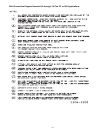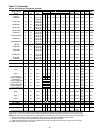
56
Unit Start-Up (Continued)
Lead/Lag Operation
When Lead/Lag is enabled, each time the system cycles af-
ter having stages 1 and 2 "On", "Stage 2" (K11 on SCM or
K3 on MCM) and the corresponding condenser fan output
"2A" will start first. The compressor module cycles the
compressors "On" and "Off" to keep the zone temperature
within the cooling setpoint deadband. The condenser fans
are cycled "On" and "Off" to maintain the saturated refriger-
ant temperature within the specified controlband.
Units equipped with 100% modulating exhaust
The exhaust dampers are controlled through an Exhaust/
Comparative Enthalpy Module (ECEM). The ECE module
receives input form a space transducer and modulates the
exhaust dampers to maintain the space pressure to within
the specified setpoint controlband.
Gas Heating Sequence of Operation
Standard Two Stage Gas Furnace
The control system for the rooftop units are wired to ensure
that the heating and cooling do not occur simultaneously.
Refer to the wiring diagram that shipped with the unit while
reviewing the following sequence of operation.
Fenwal Ignition System
(235 & 350 MBH Natural Gas)
When a heating requirement exists, the Rooftop Module
(RTM) starts the supply fan and sends a request for heat to
the Heat Module. The Heat Module closes K11 contacts
and starts the combustion blower motor (4B11). The com-
bustion blower motor starts on low speed through the nor-
mally closed combustion fan relay (4K33) contacts. The
heat module also closes K12 contacts. Power is then sup-
plied through the supply air flow switch (4S38), the com-
bustion air flow switch (4S25), the high limit cutout (4S26),
and finally through the normally closed sequencing time
delay (4DL6) contacts to the pre-purge time delay relay
(4DL5). The Fenwal ignition control board (4U18), the 60
second sequencing time delay relay (4DL6), and the com-
bustion blower relay (4K33) will not energize until the pre-
purge timer (4DL5) closes its contacts. Once closed, the
Fenwal ignition control board (4U18) energizes the 1st
stage solenoid on the gas valve (4L15), the interlock relay
(4K32), and the ignition electrode (4E1). A second set of
normally open timed closed contacts on the pre-purge
timer (4DL5) are wired into the 1U50 heat fail input in se-
ries with a normally closed set of contacts on the interlock
relay (4K32). When the commonly open contacts on the in-
terlock relay (4K32) closes, it will maintain an electrical
path for the ignition control board (4U18) and subsequent
controls after the pre-purge timer (4DL5) is de-energized
by the sequencing time delay relay (4DL6). The normally
open contacts on the pre-purge time delay relay (4DL5)
will open in the 1U50 heat fail input, preventing the Heat
Fail diagnostic.
The ignition electrode (4E1) will spark continuously for 4.7
seconds in an attempt to establish a flame. The flame is
proven by the flame rod (4U19). The system will operate in
the low heat mode until there is an additional call for heat
established by closing the K1 contacts on the Heat Mod-
ule.
The 60 second sequencing time delay relay (4DL6) will
energize the combustion blower relay (4K33) which
switches the combustion blower motor to high speed and
energizes the 2nd stage solenoid on the gas valve (4L15).
If the flame rod (4U19) does not detect a flame at the time
of an initial call for heat or detects a loss of flame during
operation, it will de-energize the gas valve and the inter-
lock relay (4K32). The Fenwal ignition control board
(4U18) will lockout automatically. If a flame failure occurs
prior to the sequencing time delay relay (4DL6) opening its
contacts which de-energizes the pre-purge timer (4DL5),
the sequencing time delay relay (4DL6) will complete its
timing. When completed, the pre-purge time delay relay
(4DL5) is de-energized, opening its contacts which discon-
nects power to the ignition control board (4U18), the se-
quencing time delay relay (4DL6), and the 2nd stage sole-
noid on the gas valve (4L15). Once power is removed from
the ignition control board, it will reset automatically. If a call
for heat still exists, after approximately 60 seconds, the
contacts for the sequencing time delay relay (4DL6) will
close, powering the pre-purge time delay circuit while tim-
ing open to the combustion blower relay (4K33) and the
2nd stage solenoid on the gas valve (4L15). The pre-purge
time delay relay (4DL5) will initiate another ignition se-
quence. The combustion blower motor will continue to op-
erate as long as a heating requirement exists and the ser-
vice switch (4S24) is "On".
Once the heating demand has been satisfied, the combus-
tion blower motor and the ignition control board is de-ener-
gized.
Propane Gas
Units that operate on propane gas have one additional con-
trol that affects the combustion blower motor operation
when a heating demand has been initiated or satisfied.
The post purge time delay relay (4DL4) is installed which
delays the starting of the combustion blower by approxi-
mately 60 seconds. Once it has timed out, the combustion
blower motor will start, closing the combustion air flow
switch (4S25). The ignition sequence will follow the same
sequence from the combustion airflow switch (4S25) to the
subsequent controls as a natural gas system.
Once the heating demand has been satisfied, the Fenwal
ignition control board (4U18) and the post purge time delay
relay (4DL4) is de-energized. The combustion blower motor
will continue to operate for approximately 15 seconds to
purge the heat exchanger on the "Off" cycle.
Honeywell Ignition System
(500 & 850 MBH Natural Gas)
When a heating requirement exists, the Rooftop Module
(RTM) starts the supply fan and sends a request for heat to
the Heat Module. The Heat Module closes K1 contacts and
starts the combustion blower motor (4B11). The combustion
blower motor starts on low speed through the normally
closed combustion blower relay (4K33) contacts.
The supply airflow switch (4S38) and the combustion air
switch (4S25) closes. Power is applied through the high
limit cutout (4S26) to the Honeywell ignition control board
(4U18). The ignition control board (4U18) starts a pre-purge
timing cycle. At the end of the pre-purge cycle, the ignition
transformer (4T7) and the pilot solenoid valve (4L9) are en-
ergized. This starts a 10 second trial for pilot ignition. When
the pilot flame is established and sensed by the flame sens-
ing rod (4U19), stage 1 of the main gas valve (4L7) and the
60 seconds sequencing time delay relay (4DL6) is ener-
gized.


















